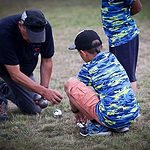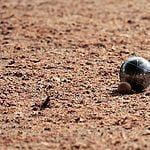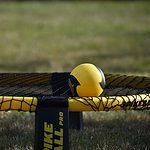As you step onto the court, your racket might as well be Excalibur, and the game of badminton your personal battlefield. In your arsenal, you have five types of shots, each with its own strategic purpose.
You'll use the clear to send your opponent scurrying to the back line, the drop shot to deceive with a gentle touch over the net, the drive to maintain a fast-paced attack, the smash to aggressively seize points, and the net shot to create difficult angles.
But knowing when and how to deploy these shots is where the true artistry of badminton lies. As you prepare to outmaneuver your opponent with these techniques, remember that it's not just about the power of the smash or the finesse of the drop; it's about the cunning combination of these moves that will keep your adversary on their toes.
Key Takeaways
- The clear shot is a versatile tool that can be used defensively or as a setup for an offensive smash.
- The drop shot requires precision and deceptive skill to challenge your opponent's ability to respond swiftly.
- The smash is a powerful offensive shot that can force your opponent into a defensive stance.
- The drive shot maintains offensive pressure and controls the pace of the game.
The Clear Shot Explained
In mastering the clear shot, you'll find it to be a crucial maneuver that propels the shuttle high and deep into the opponent's court, compelling them to move back and opening up the play for your strategic advantage. This overhead stroke isn't just about hitting the shuttle; it's a nuanced skill that involves timing, power, and precision to ensure the shuttle travels the desired trajectory.
As one of the essential Types of Badminton Shots, the clear can be a defensive tool or a setup for an offensive smash. When you're under pressure near the defensive net, a well-executed clear gives you time to recover, forcing your opponent to reposition themselves at the back of their court. This shot can shift the momentum, transitioning from a defensive stance to an offensive one.
When you hit the shuttle with the clear, aim for it to soar in a high arc, making it land at the furthest possible point on your opponent's side. This upward and deep trajectory creates a challenge for them, limiting their ability to attack with a steep downward angle. Mastering the clear shot is fundamental in badminton, as it enhances your overall game strategy and keeps your opponent guessing.
Mastering the Drop Shot
Mastering the drop shot demands precision and deceptive skill, as you subtly push the shuttlecock over the net to land in your opponent's forecourt, challenging their ability to respond swiftly. When you execute a badminton drop shot, it's vital to mislead your opponent into thinking a powerful drive is coming. As they prepare for a deeper shot, the shuttle drops quickly, limiting their response time and often securing you the point.
To perfect this stroke, you must practice varying the speed and angle, which enhances the shot's unpredictability. The key is to swing the racket with a smooth motion, disguising your intention until the last possible moment. As you bring the racket forward, make minimal backswing to maintain the element of surprise.
Your racket arm plays a crucial role; it must be relaxed but controlled to make precise contact with the shuttle. There are different types of drop shots – the fast drop shot that skims over the net and the slow drop shot that just clears the net, both requiring distinct techniques. A well-executed drop shot, akin to a net shot but with a slightly longer trajectory, can be a game-changer, setting you up for offensive plays or outright winning points.
The Power of the Smash
While the drop shot relies on subtlety and deception, the smash is your chance to unleash full power, aggressively sending the shuttlecock downward to challenge your opponent's defense. As a powerful offensive shot, the smash is pivotal in gaining the upper hand.
Here's how to dominate with the smash:
- Perfect Your Technique: To hit this shot effectively, you need to swing your racket with both speed and strength. As the shuttlecock approaches, leap and reach high, bringing your racket forward in a fluid, whipping motion. Flick your wrist at the point of impact to add extra speed, ensuring the shuttlecock descends rapidly just over the top of the net.
- Aim for Precision: It's not just about power; positioning the smash accurately forces your opponent into a defensive stance. Aim towards the sidelines or right at your opponent's body to limit their return options.
- Incorporate Variations: Mix in the jump smash for an even steeper angle. Varying your smashes keeps your opponent guessing, and a well-timed net kill can be a lethal follow-up to a smash that's returned weakly.
Executing the Drive Shot
As you transition from the explosive smash to other strategies, the drive shot becomes an essential tool for maintaining offensive pressure and controlling the pace of the game. The drive shot in badminton is executed by powerfully swinging your racket overhead. This allows the shuttlecock to fly flat over the net, creating an immediate pressure on your opponent.
When you hit the drive shot, you're engaging in a quick, counter-attacking maneuver that can be executed from mid-court to mid-court, utilizing both backhand and forehand drives.
To perform a forehand drive, you start with a split-step stance. As the shuttle approaches, lunge forward and employ a relaxed forehand grip. The racket swings through with a strong emphasis on wrist movement, generating the power necessary for the drive. This offensive shot not only forces your opponent to quickly change position but also limits their response options.
Effective use of the drive in Badminton requires precision and good footwork, ensuring you're in the optimal position to execute the shot. When done correctly, drive shots are used to sustain momentum, keeping your opponent on the defensive and setting you up for potential winning shots.
Perfecting the Net Shot
To dominate the front of the court in badminton, you'll need to execute net shots with precision, employing delicate wrist control to drop the shuttle just over the net. Perfecting the net shot isn't just about finesse; it's about tactical play. Here are some analytical insights to enhance your net play:
- Positioning and Footwork: Always approach the shuttle with balanced footwork. Positioning yourself correctly ensures you can hit a tight net shot or choose to drop shot instead, depending on the situation.
- Offense and Defense: Use the net shot offensively to create opportunities. A well-placed net shot can force your opponent to lift the shuttle, setting you up for an attacking shot. Defensively, counter your opponent's tight shots with net shots of your own to maintain control.
- Practice Makes Perfect: The timing and touch required for net shots come with consistent practice. Drills focusing on the net shot will develop your muscle memory and wrist control, making your net play both reactive and intuitive.





